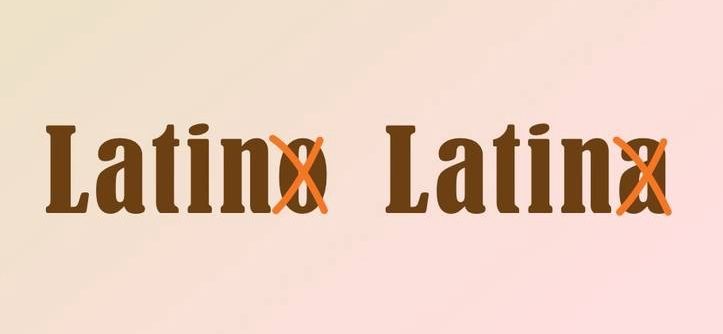Recently, the word Latinx (pronounced luh-TEE-neks) has become increasingly prominent.
The term began gaining traction after academics and activists began to use the term in the last decade. In recent years, the word has become more prominently used in media and politics, primarily by Democratic politicians.
However, the use of the word may be counterproductive in its attempt to appeal to Latino people in a gender-neutral way.
According to a poll of 100 people of Latino ethnicity conducted by The Dallas Express, only 16% selected “Latinx” as their preferred identifying term. “Hispanic” was the preferred term for 25% of the respondents, and 21% selected “Latino/Latina.”
The poll falls in line with several other surveys that have been conducted showing the term is not preferred. Only 2% of 800 Hispanic voters polled in a Bendixen & Amandi (B&A) International survey said they refer to themselves as Latinx, while 68% call themselves Hispanic.
B&A International is a Democratic firm that focuses on Latino outreach; they advised former President Barack Obama during both of his successful presidential campaigns. Their survey found that 40% of those polled are offended by the term Latinx, and 30% said they are less likely to support an organization or politician that uses the word.
“The numbers suggest that using Latinx is a violation of the political Hippocratic Oath, which is first to do no electoral harm,” Fernand Amandi, principal at B&A International, told Politico last month.
“Why are we using a word that is preferred by only 2% but offends as many as 40% of those voters we want to win?”
A 2020 survey by Pew Research found that just 3% of Hispanics use the term Latinx, and a Gallup poll last summer found that number to be about 4%.
The polls illustrating the term’s unpopularity come at a time when Republicans appear to be gaining support among Latino voters.
Historically, about 30% of Hispanics vote for the Republican nominee in presidential elections. In the 2020 election, the incumbent, Donald Trump, received just above the historical average of support from Hispanic voters, with 32% of the vote
However, several heavily Hispanic districts, including House District 31 in South Texas, saw big swings in favor of Republicans in the 2020 election.
In the 2016 election, the Democratic nominee Hillary Clinton won HD 31 by 13 percentage points. Four years later, Republican candidate Donald Trump won the same district by the same margin.
This was the trend in all the counties along the Texas-Mexico border, which are largely majority Hispanic.
Clinton won nearly all 28 Texas border counties in the 2016 election by an average of 33 percentage points. In 2020, Biden won 14 of the 28 counties by an average of just 17 percentage points.
The term Latinx has also become increasingly politicized. Last June, President Biden drew criticism on social media for saying that “it’s awful hard … to get Latinx vaccinated as well.”
During the 2020 presidential election, former President Trump’s campaign made Biden’s use of the word into a point of criticism in the election. They attempted to paint Biden as out of touch with Hispanic voters.
Could the word Latinx be one reason that some of the Hispanic community has shifted toward voting for Republican candidates?
Chuck Rocha, a Democratic strategist, says it’s “overblown to say the word is a reason Republicans made inroads. The only reason they made inroads is they actually started communicating and talking to Latinos, who they just never took the time to talk to in years past.”
The polls could be seen as in line with Rocha’s stance. The top answer in The Dallas Express poll was “none of the above,” with 38% of the vote, which could be interpreted as meaning many of those polled do not harbor a strong preference for one specific term.
The B&A International survey also found that 57% of people polled aren’t “bothered or offended” by the term, and 49% said it makes no difference if Latinx is used.
Joaquin Blaya, one of the founders of Univision, America’s largest Spanish-Language television network, says his network objects to using Latinx.
It’s “too weird, it’s dumb, it’s foreign, it’s not Spanish,” Blaya told Politico.
Blaya says his network uses Hispanic or Latino because that is accurate in the Spanish language and unites individuals across Latin America.
“Democrats are helping Republicans make them look out of touch,” said Blaya, who pointed out he was a registered Democrat.
“We built a network around our Spanish language, and we have a shared culture around it. Why are we trying to change this? It’s offensive to a lot of people.”
Kristian Ramos, a Democratic strategist specializing in Latino outreach, says the views on the term are split by generation.
“Young activists very much identify as Latinx, and then you have your general population that has no idea what that word means and finds it sort of mystifying and ridiculous,” he said.
Ramos says he uses Latinx only when talking to young or progressive voters. “Otherwise, it turns into this debate, and then it turns into this tedious, linguistic gymnastics.”
Nathalie Rayes, president and CEO of the group Latino Victory Project, said the use of the word by Democrats is attempting to recognize the diversity within the Hispanic community. Some communities, according to Rayes, prefer the term Latinx.
“We just have to be inclusive and sensitive and understand that it’s not one fell swoop across the Latino community,” Rayes said.
Spanish is a gendered language, with nouns ending in “A” for a feminine subject and “O” for masculine words. When referring to a group of people of different genders, using the masculine noun is standard — “Latinos” refers to all genders.
No Spanish words in the official language end in the letter x.






